Last Updated on February 8, 2025 by Sarah Wilson
On my recent trip to Botswana, I took a day trip from Kasane (where the incredible for wildlife spotting Chobe National Park is located) to Zimbabwe to see the extremely impressive Victoria Falls.
Victoria Falls is one of the world’s seven natural wonders and a definite must-see. It’s located on the Zambezi River, on the border of Zambia and Zimbabwe.
On the Zimbabwe side, Victoria Falls is located in the Victoria Falls National Park and on the Zambia side in Mosi-Oa-Tunya National Park. I only had time to visit the Victoria Falls National Park, but I did get a sneaky glimpse of the Zambian side of the falls without needing to pass through another border checkpoint from the Victoria Falls Bridge.
The waterfall stretches 1,708 meters across and drops 108 meters. The spray from the waterfalls can reach up to 400 meters above the drop and can be seen from as far as 30 kilometres away. This misty spray is why the locals call the falls the “Smoke that Thunders.”
I visited in July, and let me tell you, there was a lot of mist, and you just can’t fully grasp the powerful sound of the falls until you hear it!
How To Get From Kasane To Victoria Falls
The Botswana-Zimbabwe border, aka the Kazungula border, is open from 6 am to 6 pm and is only a short drive away from Kasane.
Taking a shuttle bus or a tour from Kasane to Victoria Falls is the easiest way to get there and will be a lot less hassle at the border crossing than driving yourself.
Once you arrive at the Kazungula border, you will need to visit the Botswana side to get your exit stamp. Leaving Botswana is straightforward, but be prepared to queue when entering Zimbabwe, as going through immigration from Botswana to Zimbabwe will take a while, as most nationalities will need to queue up for a visa on arrival.
When I visited, I was queuing for well over an hour.
As I mentioned, most nationalities need a visa. It’s 30 US dollars for most visitors, and you can also pay in local currency or euros or pounds. Credit cards are not accepted.
If, however, you are British, Canadian or Chinese, the visa fee costs more. For me, being British, I had to pay 55 dollars !!- I only had 60 euros on me. At this border, one euro is equivalent to one dollar. Your supposed change is considered a ‘ tip ‘ if you don’t have the exact money.
I was given the option to try and find $5 or 5 euros from someone else in the queue, but having waited an hour so far, I didn’t want to lose my place in line, so a $5 tip it was.
For Canadians, it’s even more expensive to enter! You will need $75.
Once you’ve got your visa, it’s a pleasant 45-minute drive through the Zimbabwean countryside to the falls.
Returning to Botswana from Zimbabwe is a far easier crossing as no visa is currently required for Americans, British and Europeans to enter Botswana. However, check here first to see if you need a visa, as rules change.
Arriving At Victoria Falls National Park
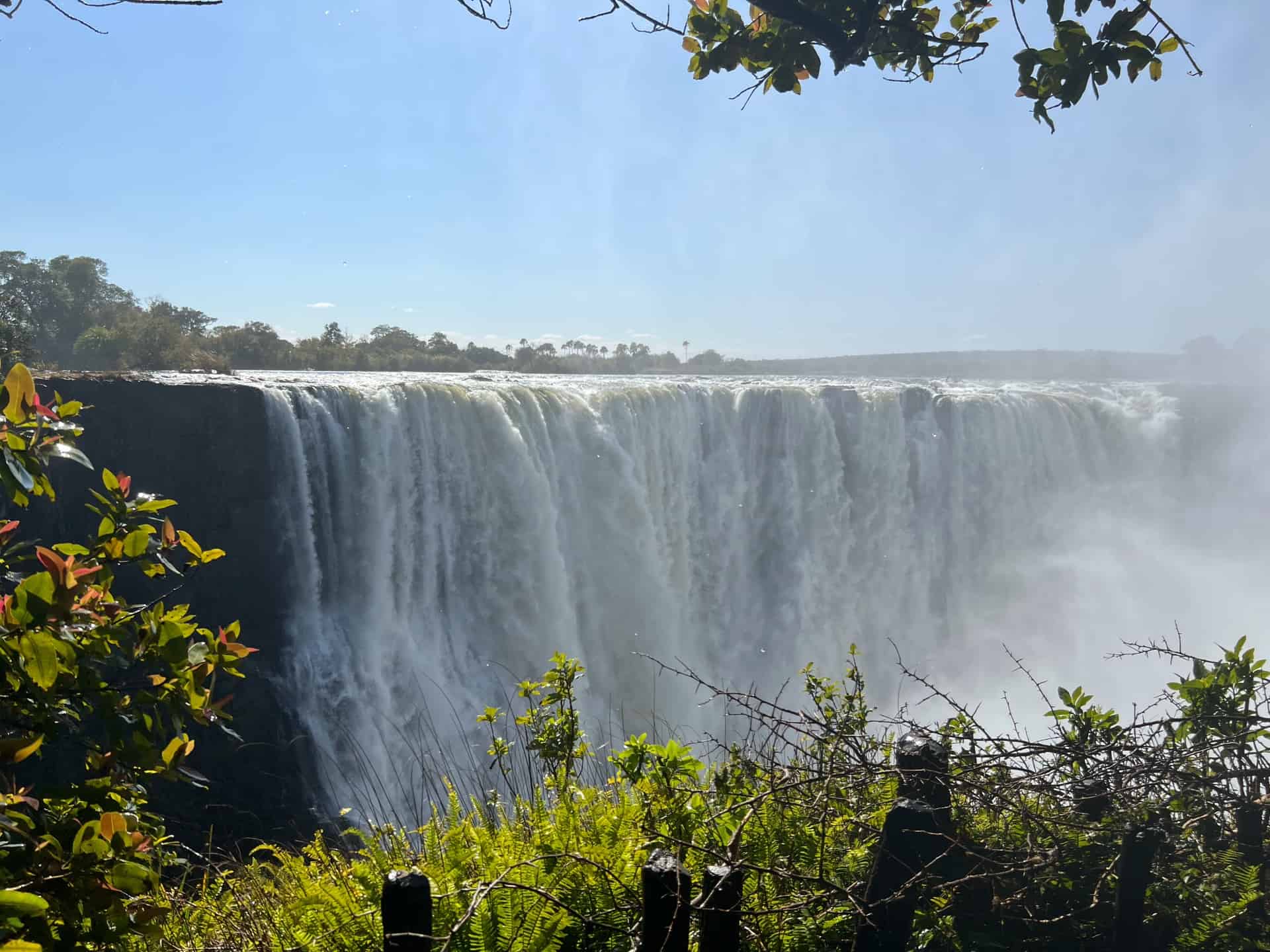
If you come from Kasane to Victoria Falls by taxi or shuttle, you will be dropped off in the car park opposite the entrance. Arrange with your driver what time you want to return. It would be best to allow yourself at least two to three hours to see the falls.
It’s also probably a good idea to note the number plate of your taxi as there will be many drivers hanging around when you return.
Within the car park, there is a curio market and vendors selling cold soft drinks and water, snacks and ice cream. If you wish to rent or buy a poncho, you can do so at this market. It costs $3 to rent a rain jacket, but don’t expect quality. And you will still get wet, but that’s part of the experience, right?
The entrance to the falls is opposite the car park.
How Much Is The Entrance Fee To Victoria Falls National Park?
It’s 50 US dollars to enter the Victoria Falls National Park, less if you have an African passport or are a local. You will need to show your passport, so don’t try and pretend to be local.
The $50 payment only covers a single entry to the Victoria Falls. So, if you decide to leave the park, you will need to pay again to re-enter. Payment can be made in cash or via credit/debit card – (MasterCard or Visa).
All children between 6 and 12 years old pay 50% of the adult fee, and children under the age of 6 enter for free.
Victoria Falls National Park Opening Hours
Summer (1st September to 30th April) – Opens 6 am until 6 pm
Winter (1st May to 31st August) – Opens 6:30 am until 6 pm
Inside The Victoria Falls National Park
Once you have paid your entrance fees and entered the park, an information centre with maps and information on the Zambezi River and Victoria Falls is in front of you. There is also a souvenir shop, the Rainforest Cafe and plenty of toilets.
Do I Need A Guide To Visit Victoria Falls?
You can easily visit the falls from either the Zimbabwean or Zambian side without a guide. The trails are well-maintained, easy to follow and have signage to explain what you are looking at.
The benefit of not having a guide is that you can explore the area at your own pace. However, the downside is that you miss out on the informative insights and historical context that guides provide.
So, if you prefer to walk with a guide, this private guided walking tour comes highly rated.
Want to explore by yourself? Simply follow the arrow to the left and enjoy the walk through the rainforest to see the 16 viewpoints within the Victoria Falls National Park.
The 16 Viewpoints Within Victoria Falls National Park
Viewpoint 1
A statue of David Livingstone facing eastwards towards the Main Falls. He was the first European to see the Falls on the 16th November, 1855 and named them in honour of Queen Victoria.
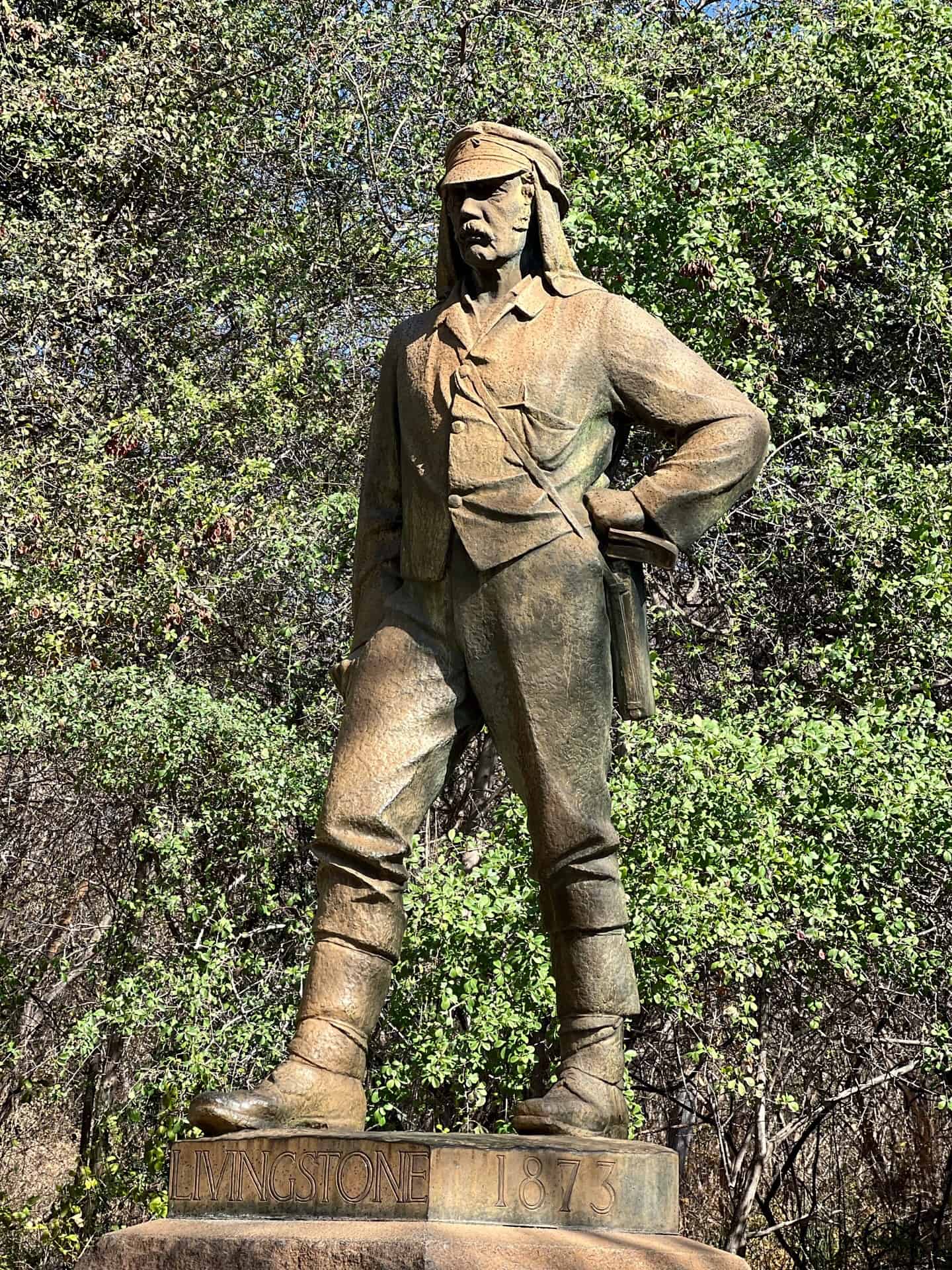
Viewpoint 2
To reach the second viewpoint, you must walk down a set of stairs to the bottom of the gorge. There are 73 very steep steps, so it’s not recommended if you’re not fit or are afraid of heights and on the day I visited, they were very wet and slippery from all of the mist.
I managed two steps before turning around; as I have to admit, I’m not good with heights and water, so I decided to skip this viewpoint.
But apparently, for the brave amongst us, from here, you get a clear view of where the gorge starts. You might even see the Main Falls from here, depending on the time of year. When the water level is really low, you can even see the shape of the gorge going beyond the Main Falls.
Viewpoints 3, 4 and 5
You get a scenic view of the Devil’s Cataract and Cataract Island, aka Baoruka Island. Among the five falls, the Devil’s Cataract, at 70 metres, is the smallest.
It is said that the missionaries who came to this region named it Devil’s Cataract after witnessing local tribes conducting sacrificial rituals there!

Viewpoint 6
This location provides the best view of the Devil’s Cataract, especially during the morning. It is positioned directly across from Cataract Island and offers a partial view of the Main Falls.
Viewpoint 7
This viewpoint is the best spot to see the Main Falls, the biggest of all the falls, measuring 93 meters deep and about 150 meters wide.
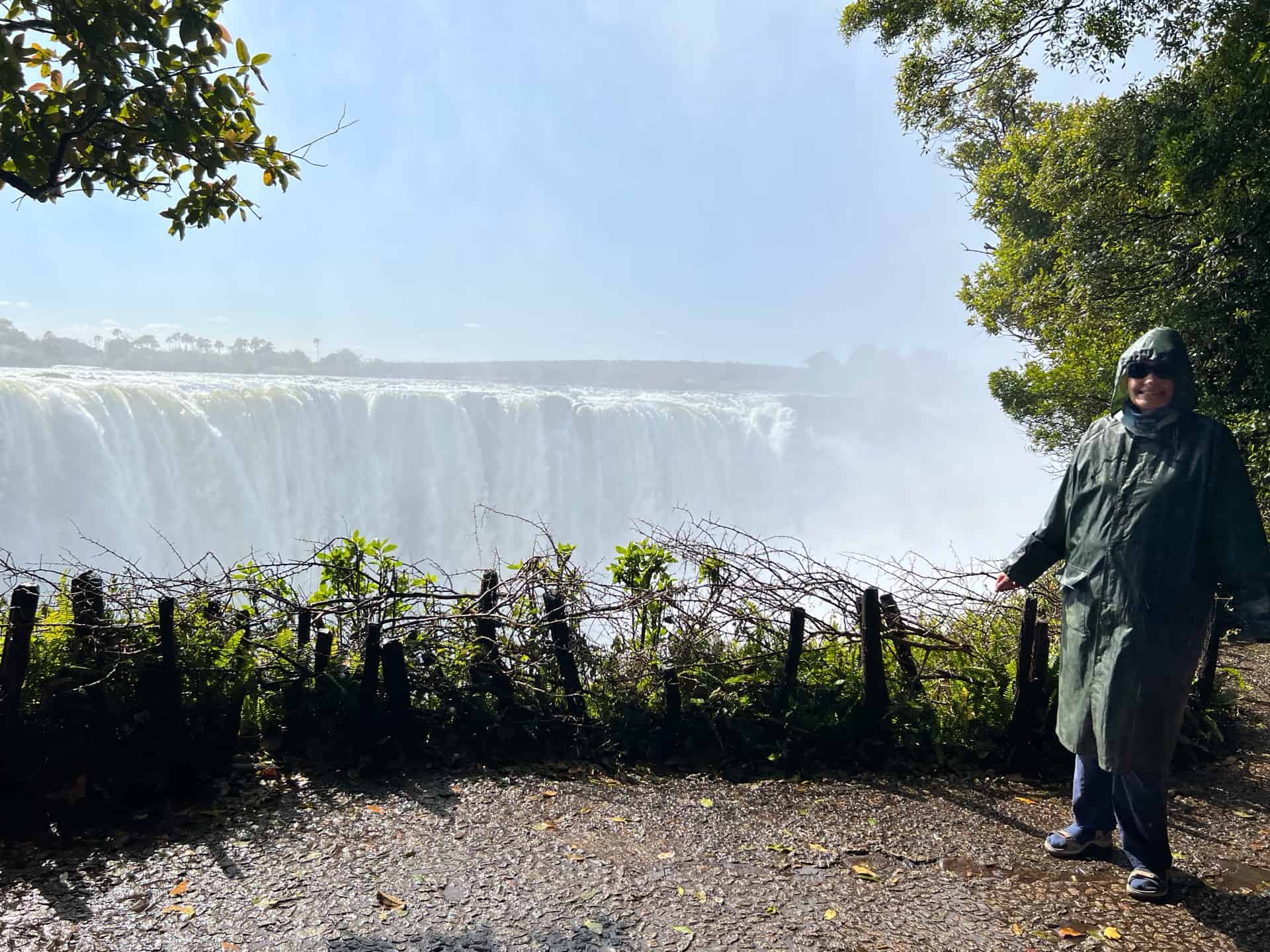
Viewpoints 8 and 9
Viewpoints 8 and 9 are directly opposite the Main Falls, but the constant spray and mist make it hard to see the falls. They are there one minute and then vanish from view, so you need to be quick with the camera.
This spot is also where you will be really pleased you have a rain jacket with you, as you will get wet.
Note that it can be quite challenging to take good photographs from here from both a visibility perspective and having to deal with wet cameras or phones. Well, that’s my excuse anyway.
Viewpoint 10
This viewpoint is right across from the Devil’s Pool, and the view is also affected by the water spray, similar to spots 8 and 9. When the water level is high, there isn’t much to see, but it offers a nice view of the final part of the Main Falls.
The Devil’s Pool is a rocky area in a volcanic vent; during the dry season, it’s possible to go swimming here.
Viewpoints 11 and 12
From viewpoints 11 and 12, you can see David Livingstone Island and the Horseshoe Falls to the right.
It’s said that David Livingstone stood across from this spot when he first saw the Falls. He had tried to measure how deep the falls were from here by lowering a line with bullets with a piece of cloth attached. The weight got stuck on a rock about 90 meters down, still far from the bottom, and couldn’t go further.
Livingstone also planted some fruit and coffee seeds on the island, naming it the Garden Island. However, the garden didn’t last long as hippos destroyed the fence and seedlings.
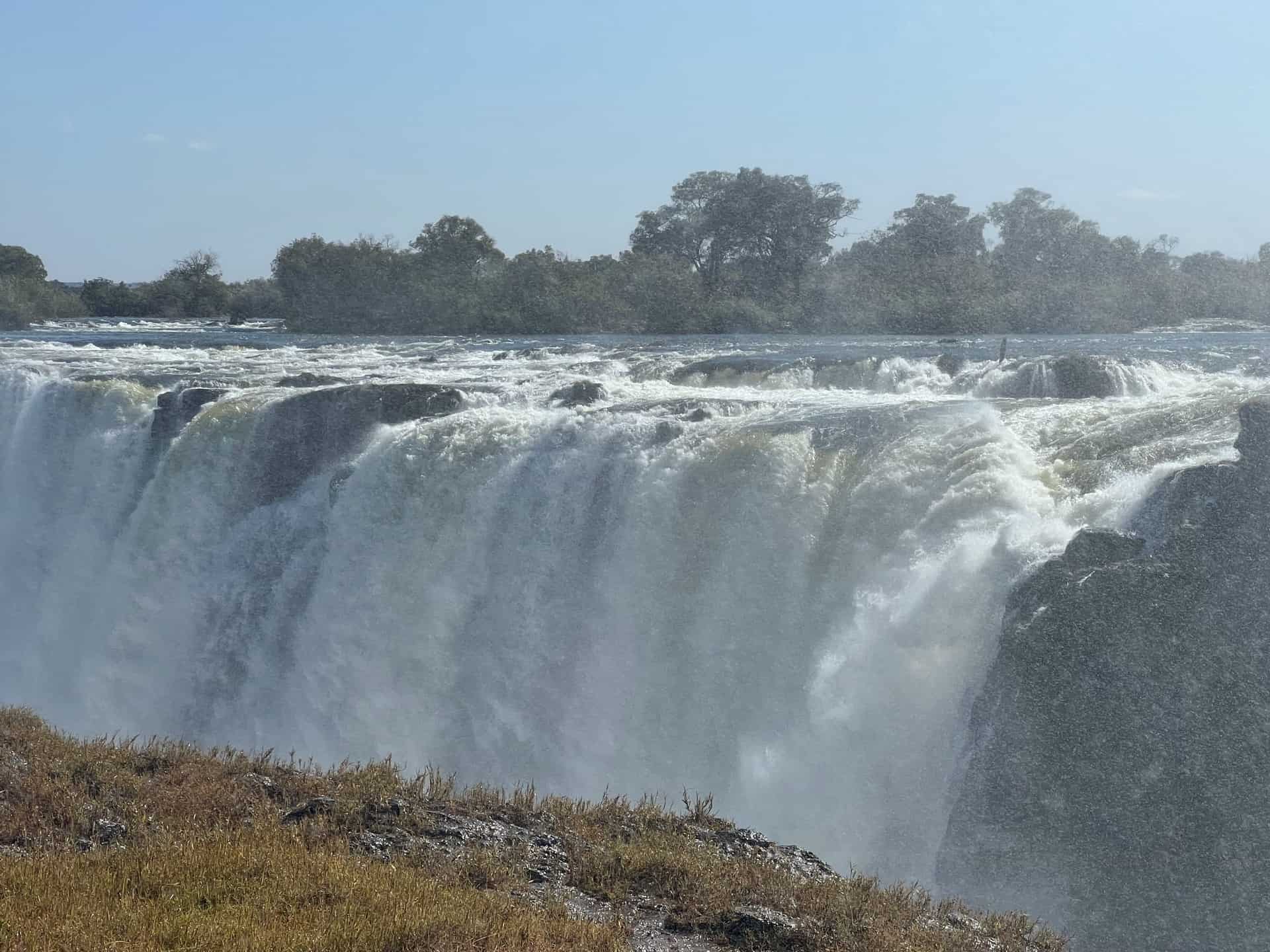
Viewpoint 13
The 95-metre-high Horseshoe Falls is a fissure eroded into a horseshoe shape over time. This section of the falls is the first to dry up during the dry season and is a popular nesting site for birds such as martins, swifts, and long-tailed wagtails.
Viewpoint 14
At 108 meters, Rainbow Falls is the tallest among all the falls and is also one of the riskiest places to watch from. But, as the name says, you can usually see a beautiful rainbow here on sunny days.
This spot isn’t fenced off from the gorge, making it unsafe not just when it’s wet and slippery in the rainy season but also in the dry season, as there’s no barrier to keeping viewers safe.
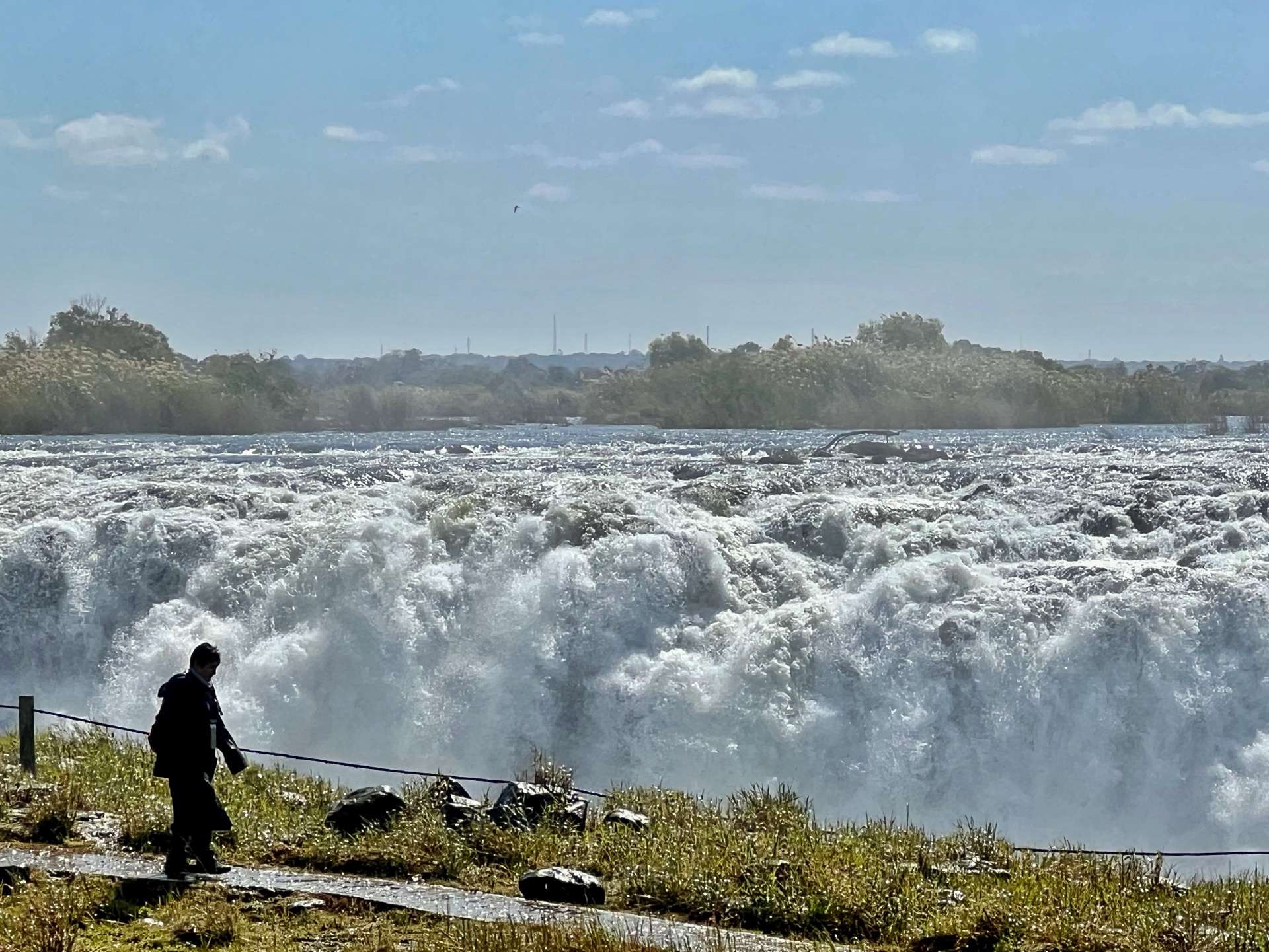
Viewpoint 15
This location is known as Danger Point, and as the name suggests, it is somewhat hazardous, especially when the water level is high.
Visitors are strongly advised to stay away from the edge here, and I did because, as I mentioned, I’m not good with heights and water, especially when you add slippery rocks to the mix.
But to fully experience Danger Point, climbing up some rocks is essential. The area, however, becomes very slippery when wet, increasing the risk of falling into the gorge, and people have!!
But from Danger Point, you can see the Eastern cataract on the Zambian side, along with the boiling pot just below it to the right.
The Eastern cataract has a depth of 101 meters. The water from the Devils Cataract, Main Falls, Horse Shoe Falls, and Rainbow Falls flows to the east, while the water from the Eastern Cataract flows to the west.
These two opposing currents meet beneath Danger Point, creating the boiling pot, and then continue to flow southwards through a narrow gap in the basalt rock between Danger Point and Knife Edge on the Zambian side.
View Point 16
You can see the Victoria Falls Bridge from here. It took two years to build the bridge, finishing in 1905. The bridge is 111 meters above the water when the water level is at its lowest. It’s approximately 198 meters long and connects Zimbabwe and Zambia.
If you feel like bungee jumping, then this is the place.

How Long Is The Victoria Falls Walk?
From the entrance gate to the first viewpoint is about 300 hundred metres. Then, from viewpoint 1 to the old bridge is around two kilometres.
Allow yourself at least two hours to visit all the viewpoints, from Livingstone’s statue to the old bridge. Longer is better.
Seeing Victoria Falls From The Victoria Falls Bridge
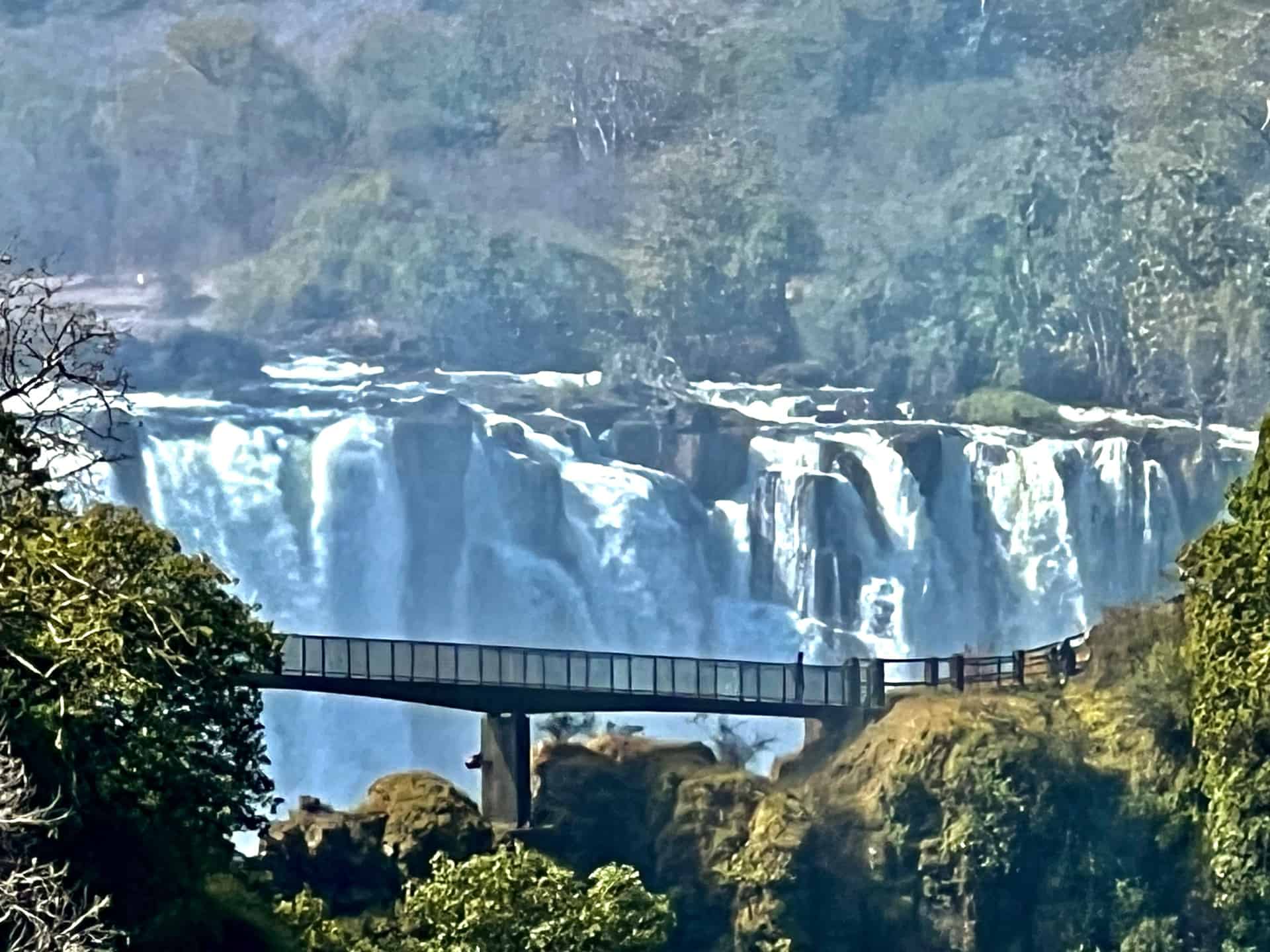
If you have more time, take a walk across Victoria Falls Bridge. The bridge is a 15-minute walk from the Victoria Falls National Park entrance or a five-minute drive. Ask your shuttle driver; he will be happy to take you.
You will need to pick up a bridge pass from immigration, but it’s free, quick and easy to do. Just ask for it at any counter.
Here, you can view Victoria Falls from yet another angle and take even more photos of the falls. You can even nip into Zambia without officially passing through a border crossing.
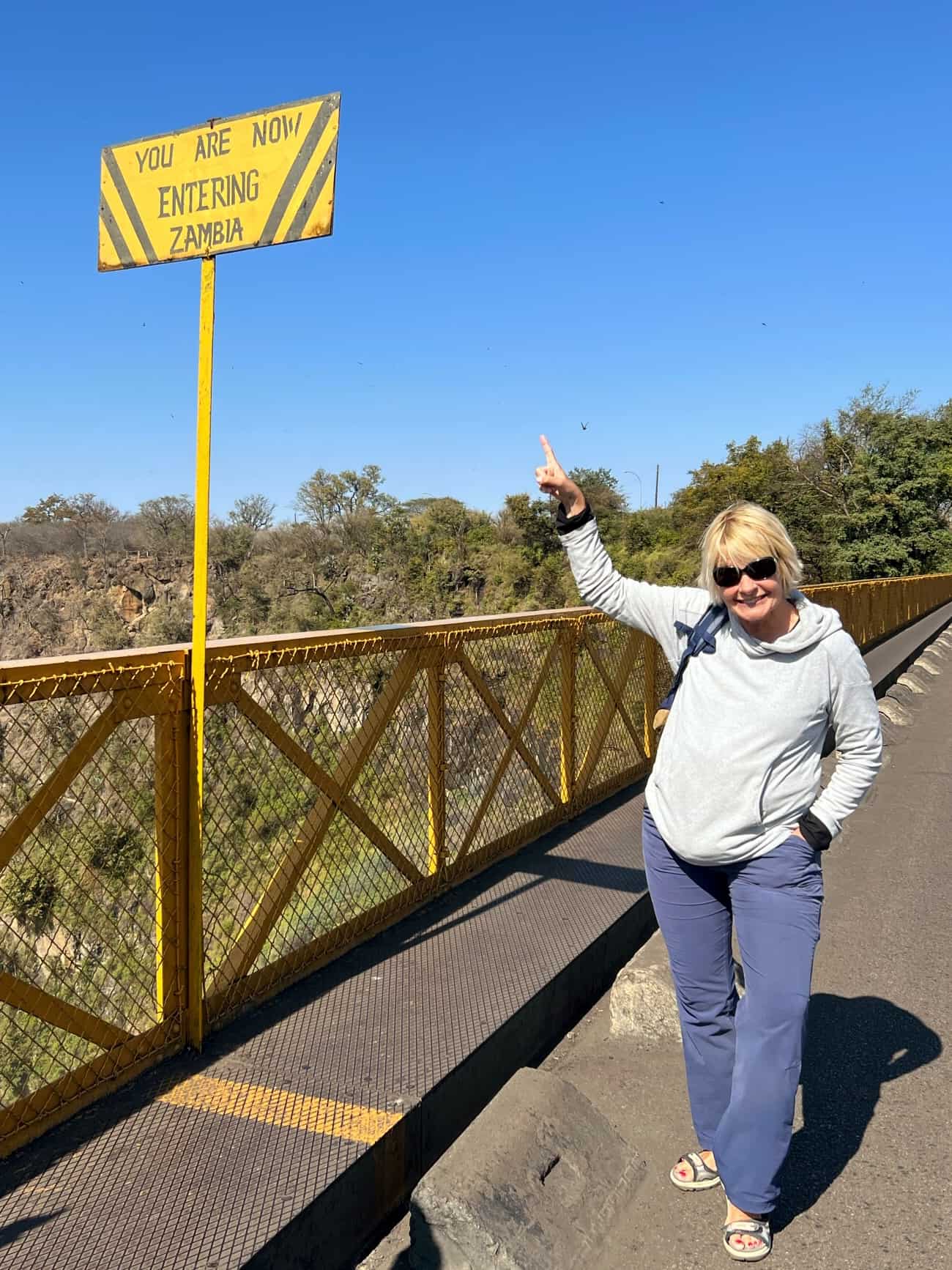
Will I Get Wet Visiting Victoria Falls?
When the water levels are high, typically between March and early July, you will get very wet, especially between viewpoints 9 to 15. The mist from the Falls can be so intense that the waterfall just disappears in a heavy mist right before you.
I visited in early July and hadn’t quite anticipated just how wet I would get.
It’s a good idea to wear fast-drying clothes and consider renting a rain poncho to shield yourself – this will also help safeguard your camera. And wear good walking sandals; those paths can be slippery when wet. Bringing along a change of clothes and storing them in your transportation is also worth considering.
Is Victoria Falls Worth Visiting From Botswana?
Most definitely, although admittedly, it’s a fairly expensive day out from Kasane to Victoria Falls once you’ve cost in visa fees, national parks fees and transportation, it’s a genuinely incredible once-in-a-lifetime experience.
For More Posts On Africa, Check Here
Kolmanskop, Namibia’s Ghost Town
Best Things To Do In Rabat Morocco
Best National Parks In Botswana
One Day In Chefchaouen, Morocco’s Blue City
Visit Atlas Studios – The Hollywood of Morocco
Amazing Pictures of the Temple of Kom Ombo, Egypt
Temple of Isis at Philae, Egypt
Over 50 Travel in Egypt With On the Go Tours
Planning on Visiting Madagascar?
Pin This Post On Kasane To Victoria Falls For Later
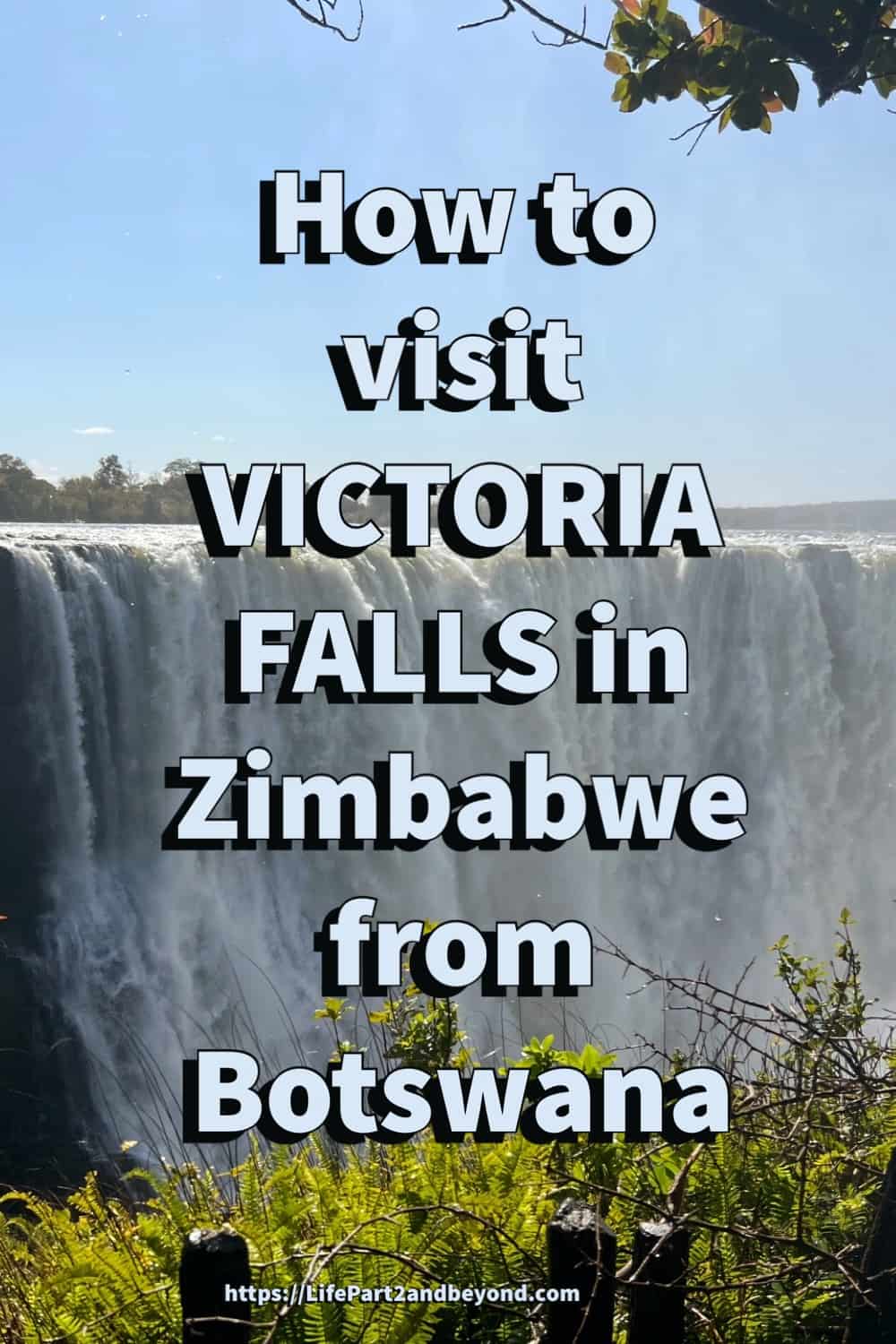
Disclaimer: Some of the links on this website are “affiliate links”, meaning that if you click on the link and make a purchase, I will receive a small commission at no extra cost. This helps me to keep my website running and continue to share my travelling knowledge with you. I thank you for using the links on my website.






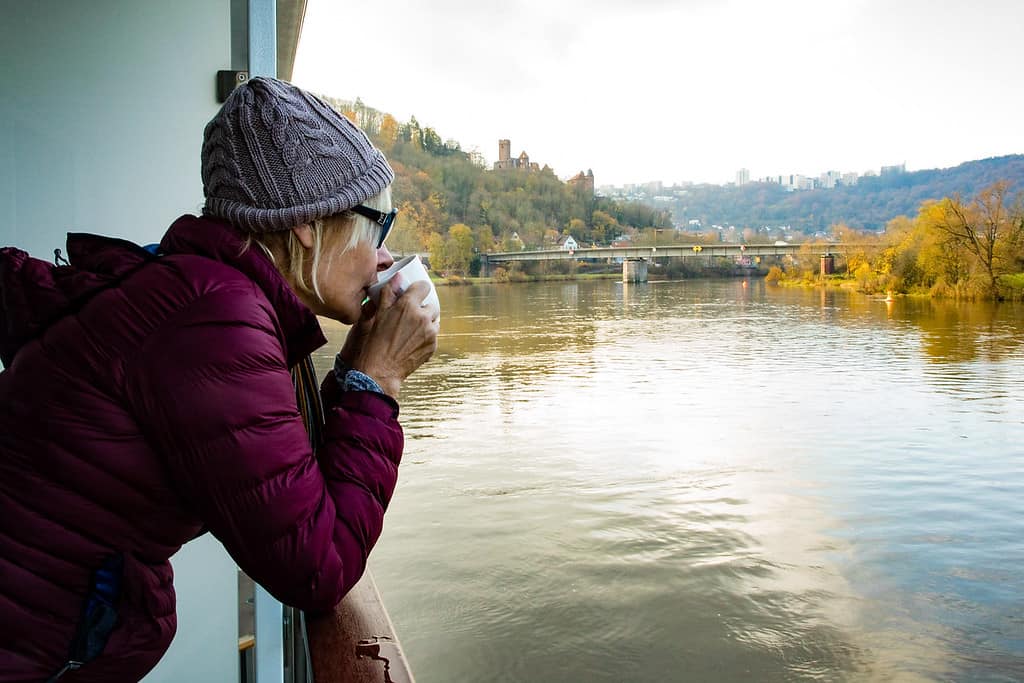
Botswana is one of my favorite Top Gear specials 😀 It has so many beautiful waterfalls!!
I visited Victoria Falls when I was a little kid and I’d love to go back as an adult. I loved reading all your helpful tips for a visit! I’ll have to look back at this post for a future trip. Thanks for sharing!